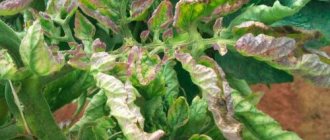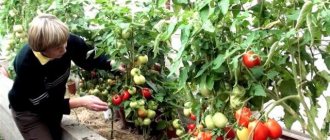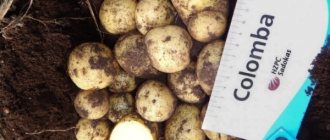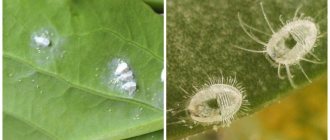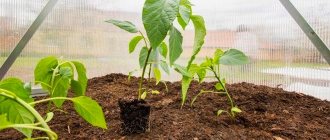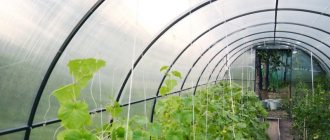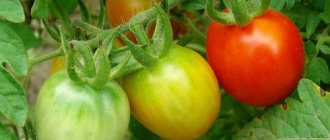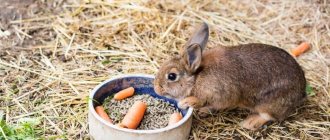Related Posts
- How to protect tulips from mice
- How to poison bedbugs: various means and methods of destruction
- Effective protection of the garden from diseases and pests
Plant diseases Fighting late blight in a polycarbonate greenhouse Late blight is a fungal disease characterized by the appearance of black spots on fruits, leaves and stems. When growing cucumbers and nightshade crops in polycarbonate greenhouses, some gardeners mistakenly believe that their vegetables are reliably protected. But fungal spores easily penetrate the shelter and infect plants. By carrying out preventive treatments and using various methods to combat late blight in the greenhouse, you can prevent the spread of the disease and get a good harvest.
Signs and danger of late blight in a greenhouse
Late blight is one of the dangerous fungal diseases that has recently become increasingly widespread on land. This is especially true for the middle zone with its unpredictable weather conditions.
The disease is caused by spores of the fungus of the same name. Most often it affects nightshade crops such as tomatoes, potatoes, eggplants, and peppers. He is also a frequent visitor to the greenhouse where heat-loving crops grow.
One of the first signs of plant damage by late blight is the appearance of brown or gray-black spots on the back of the leaves. If measures are not taken in a timely manner, the disease will spread first to the shoots of the plant, and then to its fruits.
For example, tomatoes develop black or gray hard spots that eventually begin to rot. Often late blight on tomatoes manifests itself in rotting of the fruit near the stalk. In any case, vegetables lose their commercial characteristics and cannot be stored. In advanced forms, late blight can destroy up to 70% of the crop.
Greenhouses are the best place for the spread of spores of harmful fungi. High humidity and sudden changes in day and night temperatures only contribute to its reproduction. In cool summers, plants in a greenhouse become an excellent target for attack.
What is late blight and why is it dangerous?
The appearance of the plant disease resembles a dense cobweb. Late blight spores include mycelium, sporangium and conidium. The development of the fungus occurs directly in plant tissues, which complicates its detection and elimination. It develops there until the spores mature, after which the shell opens and the spores move to other parts of the plant. A favorable environment for development is a temperature above 10 degrees Celsius. Treating a greenhouse against late blight is an important task, since the greenhouse has all the favorable conditions for the development of the fungus.
At temperatures below 10 degrees Celsius, the spores do not die. Even in severe frosts they remain alive. The presence of a plant disease can be determined by dark spots appearing on the stems and leaves. Noticeable spots also appear on the inside of the leaves. When the fruits appear, the fungus spreads to them. This is especially noticeable in potatoes and tomatoes. In addition to the formation of spots, the fruits receive a softer structure at the site of late blight. This allows the fungus to infect the plant more and make it unsuitable for nutrition. If left untreated, food will rot.
Some gardeners want to preserve the harvest and at the same time avoid treating tomatoes for late blight in the greenhouse, picking green fruits so that they ripen on their own. This does not help, since the tomatoes are already infected. Do not allow them to come into contact with other plants.
What needs to be done in the fall in the greenhouse after late blight
What to do in the fall in a greenhouse where late blight was rampant in the summer. This question worries many vegetable growers who do not want to continue to fight for the harvest next year, treating plants with all sorts of means that are not always effective and safe for health.
Preparatory work
Before you start treating greenhouses and greenhouses against late blight in the fall, they should be prepared. They remove the remains of plants, weed weeds, cut off the twine for tying shoots, and remove all removable structures and supports from the greenhouses. Remove the film covers. Replacing it will be cheaper than trying to wash and disinfect it.
Possible mistakes when fighting late blight
Despite the abundance of means and methods to combat late blight, this disease appears in many gardens every summer. The cause of the disease is often gross mistakes made by gardeners.
Common mistakes:
- The use of sprinkling when watering beds. Tomatoes can only be watered at the root. The optimal method of soil moistening is drip irrigation.
- Incorrect feeding. In order for tomatoes to successfully resist the late blight pathogen, they must be fed with potassium-phosphorus fertilizers. Do not overuse nitrogen fertilizers.
- Watering during illness. If late blight has already appeared on a tomato plantation, watering them is strictly prohibited. High humidity will only enhance the development of pathogens.
- Using several methods. You cannot use different methods of struggle at the same time. Combining chemicals is especially harmful. Plants die from an excess of “chemistry”, and their fruits accumulate a critical amount of poisons.
An experienced gardener will tell you how to fight late blight on tomatoes in the following video:
Despite the destructiveness of late blight for tomatoes, it can be successfully combated. There are dozens of simple and effective methods that can not only treat this fungal infection, but also prevent it.
0
0
Copy link
Timing of greenhouse treatment after late blight in autumn
You can treat the greenhouse in the fall against pests and late blight at any time convenient for the gardener. There are only two conditions:
- the harvest must be harvested, and the greenhouse itself must be prepared for processing;
- the air temperature should not fall below 10-12 degrees Celsius, since at lower temperatures some drugs lose their effectiveness.
As a rule, most gardeners treat greenhouses and greenhouses against late blight in the first two months of autumn - September or October.
Preventive actions
Prevention of late blight is the best way to spread the disease in a confined greenhouse space. A set of actions aimed at preventing the development of late blight includes:
1. Autumn treatment of the greenhouse, consisting of cleaning and destroying the remains of plants and auxiliary elements - pegs, supports, trellises, treating the room with disinfectants, sulfur bombs.
2. Disinfecting the soil by steaming it with boiling water or treating it with chemicals.
Attention! An effective method of protection against late blight is to annually update the soil layer to a depth of 5 cm with a new one.
3. Selection of disease-tolerant hybrid forms and varieties, as well as pre-sowing half-hour disinfection treatment of tomato seeds. Growing ultra-early varieties of tomatoes and cherry tomatoes will also help avoid the spread of late blight.
4. Additional spring pre-sowing soil treatment with tobacco or garlic infusion.
Attention! If disinfectant cleaning of the soil was not carried out in the fall, then in the spring before planting, you should definitely treat the soil with a solution of bleach or copper sulfate.
To prevent late blight, it is necessary to carry out preventive measures
5. Compliance with the conditions of agricultural technology - crop rotation, selection of plants for partner and neighbor plantings, planting density, pinching, tying, thinning the crown, removing fallen plants.
6. Maintaining a stable temperature in the greenhouse, without sudden changes, watering in the morning, avoiding waterlogging, organizing ventilation.
7. Two to four times treatment with fungicidal preparations – “Fitosporin”, “Acrobat”, “Zaslon”, “Bio-fungicide” “Barrier”, “Pennkozeb” and others. It is recommended to carry out the first spraying after the transplanted seedlings have taken root in the new location, and repeat spraying after 2-3 weeks.
Attention! Treatment against late blight with industrial preparations is possible no less than 3 weeks before harvest. To avoid adaptation of pathogens to the drug used, it is recommended to change it annually to another one.
Late blight can be combated using medications. as well as folk remedies
Processing rules
It is advisable to carry out late blight treatment in the fall before the air temperature drops to 10 degrees Celsius. The exception is their disinfection using low temperatures.
Since greenhouses are closed spaces, you should not wait for favorable weather conditions. But you should prepare gloves and closed clothing. When working with chemicals and sulfur bombs, respiratory protection will not hurt. Before carrying out work, children and pets are removed from the treatment area.
other methods
Along with fungicides and folk remedies, other methods are also used to combat late blight. The advantages of alternative methods are simplicity, cheapness and efficiency.
Bordeaux mixture
This popular remedy is a mixture of quicklime and copper sulfate. Only the affected parts of the plants are sprayed with the prepared solution. During the season, 4 treatments are carried out. Intervals between spraying are 7-12 days.
How to prepare and use the solution:
- Mix 100 g of copper sulfate and 150 g of lime (quicklime) in a bucket of warm water. Follow the sequence of actions - first dissolve the vitriol, then the lime.
- Spray tomatoes using protective equipment. The weather should be clear and calm. The optimal time is morning and evening. Consumption rate – 1 liter of solution per 5 square meters. m.
It is forbidden to prepare a solution of Bordeaux mixture in a metal container. It is recommended to use utensils made of plastic, glass or wood.
Copper sulfate
This universal and inexpensive remedy has antimicrobial and antifungal effects and helps against a wide variety of diseases. Practical experience shows that the product effectively prevents late blight.
Benefits of copper sulfate:
- suitable for different crops;
- kills spores located on plants and in the soil;
- is considered a low-hazard substance;
- It is partly a fertilizer, as it contains copper, which is necessary for the functioning of cells.
A lack of copper leads to inhibition of the development of tomatoes - their ovaries and fruits do not form, and the leaves turn brown and die.
Dosage, g/10 l:
- for soaking seeds – 1;
- for spraying bushes – 10;
- for soil disinfection – 100.
How to prepare a 1% solution for irrigation:
- Dilute 100 g of powder in 1 liter of warm water heated to +40°C.
- Make a blue solution in a bucket by adding 9 liters of water.
- If the crystals have not completely dissolved, strain the solution through a piece of gauze.
- Use the composition within 9 hours. The next day the solution will be ineffective.
Mulching
Mulching is a universal agricultural technique that allows you to achieve several goals at once. You can use peat or compost for mulch.
Mulching effect:
- preventing soil drying out;
- avoiding excess watering;
- protection against fungi living in the soil.
Mulching is especially necessary when planting tomatoes without tying them up, when the bushes are partially in contact with the ground. If you do not add a layer of mulch, the pathogen, climbing the leaves in contact with the soil, penetrates the stem. If this happens, then late blight cannot be stopped. All that remains is to collect the fruits and put them for ripening.
Using Copper Wire
Phytophthora fungi are extremely sensitive to all copper-containing drugs. They are afraid of copper in any shape or form. This is the basis of another method of combating late blight. For this you will need a coil of thin copper wire.
Procedure:
- Wrap the wire around the tomato stems at the root collar.
- Cut a piece of wire about 3-5 cm long and pierce the stem at the base with it. Bend the ends of the wire to the ground.
This method can only be used for well-developed bushes. Otherwise, you can destroy the plants.
Prevention measures
One of the main measures to prevent late blight is maintaining cleanliness in greenhouses. Timely weeding, inspection of plants and removal of diseased shoots will help preserve the harvest. There are no compost heaps near greenhouses.
It is also important to maintain the humidity level not higher than 70-75%. To do this, greenhouses are regularly ventilated and are not closed less than 30-40 minutes after watering. In the fall, when damaged plants are found, they are burned or taken off site.
Folk remedies
For those who do not want to use chemicals to fight diseases, you can fight the disease using proven folk remedies.
- Garlic infusion . Known for its bactericidal properties, it effectively helps in the fight against late blight. To prepare the infusion, take 0.5 kg of garlic per 3-5 liters of water and leave for 2-3 days, then filter. Next, add water to 10 liters and spray every 2 weeks during the period starting from fruit set.
- Kefir or whey . Lactic acid bacteria help prevent disease and are effective in treatment. To treat with whey, it is diluted in a 1:1 ratio with water. If kefir is used, then a liter of fermented milk product is diluted in 10 liters of water. The resulting solution is sprayed on the stems and leaves (especially on the reverse side). Treatment can be carried out even daily.
- Ash . This product contains phosphorus, potassium, calcium and is a complex fertilizer for tomatoes. And the ash solution gives good results in the fight against late blight. To prepare, you need to mix half a bucket of ash with 10 liters of water and leave to infuse for 3 days, stirring occasionally. Strain the resulting composition and bring it to 30 liters with water, add a piece of grated soap or 30-35 ml of liquid soap for better adhesion of the solution to the leaves.
Treatment with ash solution is carried out three times. The first time is 10 days after planting the seedlings in the greenhouse, the second time is at the beginning of flowering, then when the first ovaries appear.
- Nettle infusion . Treatment with fermented nettle infusion accelerates the growth of tomatoes and prevents late blight. To prepare the infusion, pour 1 kg of green mass into 10 liters of water and leave for 1-2 weeks. The resulting composition is filtered and diluted in a ratio of 1:10 (1 liter of infusion per 10 liters of water). Spraying is carried out throughout the entire growing season.
- Yeast . The use of this remedy helps stop the development of the disease, in addition, it is an excellent prevention. To obtain a solution, 100 g of yeast (live) are diluted in 10 liters of warm water. The resulting mixture is sprayed onto the tomatoes and watered into the furrows. Such watering acts as additional feeding and increases the number of ovaries. It is better to start treatment before the first signs of the disease appear.
- Iodine . It has antiseptic properties, and in combination with milk it creates a thin film on plants that protects against the penetration of harmful spores. Preparation: for 10 liters of water, take 1 liter of milk and 20 drops of iodine. Tomatoes in the greenhouse are regularly treated with this solution. An additional property of this composition is that fruit ripening is accelerated.
